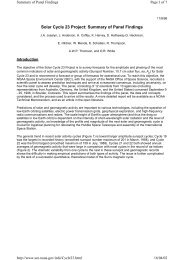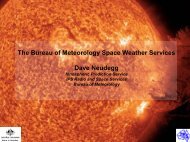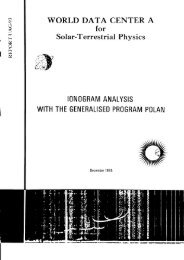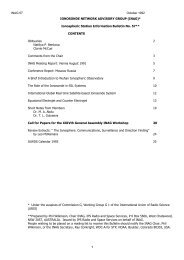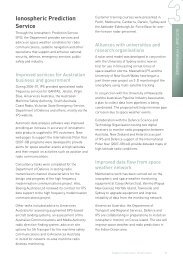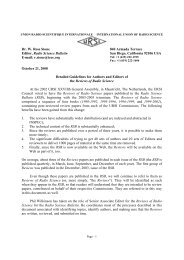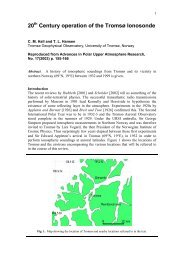Transequatorial Radio Propagation - IPS - Radio and Space Services
Transequatorial Radio Propagation - IPS - Radio and Space Services
Transequatorial Radio Propagation - IPS - Radio and Space Services
Create successful ePaper yourself
Turn your PDF publications into a flip-book with our unique Google optimized e-Paper software.
Because the intermediate ray is between two parts of the F layer, the grazing angle at the ionosphere<br />
can be substantially smaller than for a ray reflected back to the ground. This in turn implies that a<br />
higher frequency may be reflected (fr= foF2*sec(i)). Here i is the angle of incidence at the ionosphere,<br />
<strong>and</strong> as this approaches 90 (the grazing angle g=90-i tends to zero), the maximum possible reflected<br />
frequency (fr) becomes larger. Another way of saying this is that the obliquity factor of the circuit is<br />
higher. The smaller grazing angle is also made possible because the increased ionisation at the anomaly<br />
crest follows the magnetic field lines <strong>and</strong> is tilted slightly upward toward the equator.<br />
High signal strength observed for afternoon TEP are due to the smaller number of passages through the<br />
D-layer, <strong>and</strong> because the anomaly crests support propagation of signals from a wider range of elevation<br />
angles than with usual propagation modes, the distribution of ionisation in the equatorial anomaly<br />
tending to focus these along the path.<br />
The characteristics of aTEP are:<br />
� Maximum useable frequency (MUF) up to about 60 MHz, which is usually about 15 to 25<br />
MHz above the 2F mode frequency for the same path.<br />
� Occurs from around 1500 to 1900 local time. It is more prevalent near the equinoxes <strong>and</strong> at<br />
times of high sunspot number.<br />
� Typical path lengths will be from 5000 to 6500 kilometres.<br />
� Signals will normally be strong with limited fading <strong>and</strong> distortion (from multipathing or<br />
Doppler spread).<br />
5 eTEP (Evening TEP)<br />
Evening transequatorial propagation generally supports much higher frequencies than aTEP <strong>and</strong> has, on<br />
rare occasions, been reported on the 432 MHz amateur frequency b<strong>and</strong> (low UHF). Evening TEP is<br />
strongly correlated with the existence of range spreading, called equatorial spread F, seen on equatorial<br />
ionograms. Evening TEP propagation is not as well understood as aTEP but it is believed to take place<br />
via a whispering gallery or field-guided mode which relies on the existence of ionospheric bubbles,<br />
tubes or plumes that have an electron concentration lower than the surrounding area. Rays are reflected<br />
from the surfaces of the bubble walls, at all times staying within the ionosphere until they finally<br />
emerge on a path down to the ground.<br />
The characteristics of evening TEP are:<br />
� Occurs around 2000 to 2300 local time, <strong>and</strong> is more frequent around the equinoxes <strong>and</strong><br />
especially at times of high sunspot number.<br />
� Although signal strengths are high, the signal is subject to deep <strong>and</strong> rapid fading <strong>and</strong> very<br />
strong distortion (from multipathing <strong>and</strong> large Doppler motions). Doppler spread up to 2kHz<br />
has been observed on a CW signal.<br />
� Path lengths may vary from 3000 to 8000 kilometres.<br />
� Frequencies supported are higher than for aTEP <strong>and</strong> may very occasionally rise into the low<br />
UHF b<strong>and</strong>.<br />
6 Diagnostics for TEP




